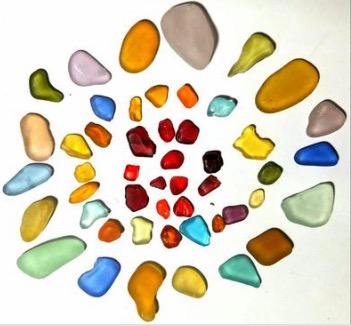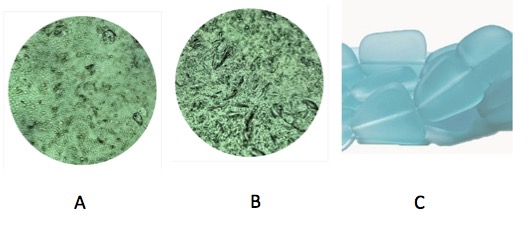
If there is one thing that makes ocean lovers crazy, it is trash on the beach, and the worst kind is plastic trash. Unfortunately, we use a whole lot of plastic and aren't especially careful about what happens to it when we're done with it.
So, we are seeing more and more of this, especially in poorer parts of the world.

Credits: (Left) Wikimedia Commons. (Right) NDLA support (National Digital Learning Arena and Creative Commons
On the other hand, a very special place in Russia has an entirely different kind of garbage "problem." But, it isn't really a problem at all. Quite the opposite. Ussuri Bay in Siberia, is one of the most unique beaches in the world. Its garbage is more like treasure—sea glass (1), a beachcomber's delight that we rarely see anymore. (2,3)
It's not that the Russians didn't dump anything in the ocean. The area is home to glass manufacturing plants, which have been dumping glass and porcelain into the waters for decades, during which time physical and chemical changes took place. Sea glass (when it's "mature") is neither sharp nor shiny, so you can even walk the beach barefoot, at least part of the time. The water temperature in January is a ghastly 32º F, but by late July it reaches 72º—about the same as Miami Beach in the winter. The beach at Ussuri Bay is so beautiful that it has become a very popular tourist attraction. 
Ussuri Bay, Siberia. Photos: The Siberian Times on Twitter
But, probably not for the weekend:

There is some rather interesting science involved in the formation of sea glass. Although glass is one of the most environmentally stable materials on earth, it does undergo chemical and physical degradation, which is what gives it its unique properties. The reason that sea glass can form at all is because of chemicals that are added during its manufacture.
Pure glass sand/quartz (silicon dioxide) is a nightmare to work with. It takes extreme temperatures to melt silicon dioxide— 3,133 o F—and even when melted, it forms a highly viscous syrup that is difficult to pour. Both of these properties can improved by adding a number of different mixtures of chemicals called a flux, the most common being "soda-lime." Soda-lime glass is the most commonly used type of glass (windows, jars, drinking glasses...). The name is slang - soda (sodium carbonate), and lime (calcium oxide).

The structures of glass (left) and soda-lime glass (right). Note the incorporation of calcium and sodium into the molecule Photo: Pilkington Glass
Even when new, glass absorbs a small amount of water in its surface. When the shiny surface is pitted by exposure to sand—a process than can take 50 years—more water is absorbed deeper into the glass. This causes the sodium and calcium, both of which are soluble In water (especially in salt water) to slowly leach out of the glass, leaving empty pores. It is the combination of the mechanical and chemical assault on the glass that gives sea glass its unique frosty finish.
The process cannot be hurried. Although it is possible to make "fake sea glass" by breaking up bottles and spinning the glass with sand in a cement mixer, even a novice collector will be able to spot it instantly. The shape, symmetry, and uniform finish are dead giveaways. 
Microscopic images of the surfaces of "new" (A), and "finished" sea glass Photo: Exploring the Invisible
Man-made sea glass (C) Photo: Jewelry By the Sea
So, now you have everything you need to know to plan your next trip to Siberia. But, it's a really long trip. You might want to fly first glass class.
Notes:
(1) Although the terms "sea glass" and "beach glass" are often used interchangeably, they are not identical. Sea glass is formed in the ocean. Beach glass is found near lakes or rivers.
(2) Sea glass has become so rare in these days of plastic that there is even a group, The North American Sea Glass Association, which celebrates the stuff. Orange and red are very rare, and a single piece of either can be worth hundreds of dollars. Blue is the most popular. Most of it comes from Philipp's Milk of Magnesia and Noxema bottles. Most of the red glass is from running lights of old ships.
(3) Northern California's Glass Beach, near Ft. Bragg was also formed by using the ocean as a garbage dump. Over the years, everything else decayed or rusted, leaving only the glass behind. The colors and variety of the glass found at Glass Beach do not even compare with what is found in Siberia.



